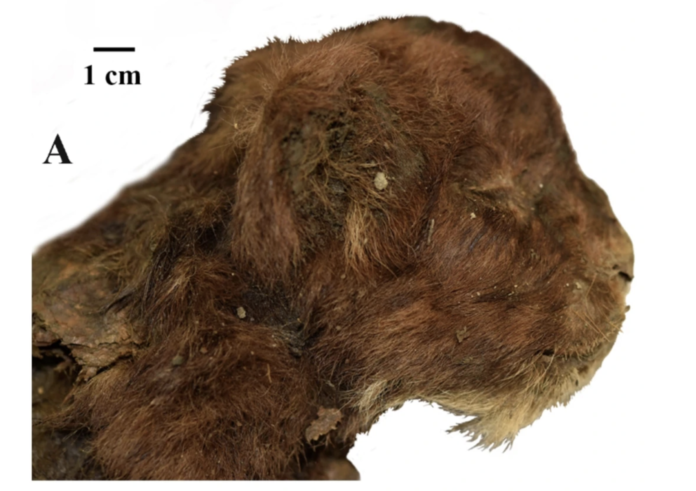Amidst the permafrost in Yakutia, Russia, researchers uncovered a mummified saber-tooth cat cub (Homotherium latidens). The well-preserved mummy, still covered in fur, is a first-of-its-kind discovery and could reveal more about the ancient species.
According to recent findings in Scientific Reports, researchers discovered the cub on the banks of the Badyarikha River. Carbon dating indicates that the specimen is over 30,000 years old, proving the cub lived during the Ice Age or Pleistocene epoch.
This area of Siberia is home to other prehistoric finds, such as woolly mammoths and rhinos; however, according to the study, finding mummified big cats is rare. Other big cats found in the area included a 28,000-year-old cave lion with whiskers still intact. Paleontologists are hopeful that this find could provide a plethora of information on saber-tooth cats.
Feline Mummy Comparison
External appearance of three-week-old heads of large felid cubs, right lateral view: (A) Homotherium latidens (Owen, 1846), specimen DMF AS RS, no. Met-20-1, frozen mummy, Russia, Republic of Sakha (Yakutia), Indigirka River basin, Badyarikha River; Upper Pleistocene; (B) Panthera leo (Linnaeus, 1758), specimen ZMMU, no. S-210286; Recent. (Credit: A. V. Lopatin)
The remains of the Badyarikha mummy consisted of its head, chest, and front legs. Detached pieces of its pelvis and forelegs were also recovered. The mummy still had its fur and tissue, including muscle, foot pads, and claws.
The cub had longer hair on the back of its neck than on its legs, along with longer hair under its chin and around its mouth. After analyzing its teeth, the research team believed that the cub was around three weeks old when it died.
Experts at the Borissiak Paleontological Institute, Russian Academy of Sciences (PIN) then compared the Badyarikha mummy to the remains of a modern-day lion cub (Panthera leo) from the Zoological Museum, Moscow Lomonosov State University (ZMMU). The lion cub was around the same age when it died. Researchers also used several other P. leo skulls to compare against the Badyarikha mummy.
According to the comparative data, it’s likely that the Badyarikha mummy would have had 12 pairs of ribs compared to the 13 pairs of ribs of a modern-day lion. The Badyarikha mummy also had larger oral fissures than the lion cub and a longer neck with thicker muscles.
Because the Badyarikha mummy’s front feet were so well preserved, the team could determine that the mummy had similar claws to those of P. leo.
Read More: Saber Teeth are as Mysterious Evolutionarily as They are Iconic Visually
Future of the Badyarikha Mummy
Because of this rare and well-preserved find, researchers are hopeful to uncover more about saber-tooth cats.
“The study of the mummy of the Homotherium latidens cub made it possible for the first time to observe its fur, the shape of its muzzle, the shape and position of the auricle [ear], the morphology of the mouth opening and nasal planum,” wrote the authors in the study.
The mummy also gave researchers a better look at the species’ paws and how its muscle mass would have been distributed. Moreover, this finding further proves that saber-tooth cats were present in the Late Pleistocene of Asia. With access to this specimen, it may be possible for researchers to put together a better feline evolutionary map.
Read More: Everything You Need to Know About the Saber Tooth Tiger Extinction
Article Sources
Our writers at Discovermagazine.com use peer-reviewed studies and high-quality sources for our articles, and our editors review for scientific accuracy and editorial standards. Review the sources used below for this article:
A graduate of UW-Whitewater, Monica Cull wrote for several organizations, including one that focused on bees and the natural world, before coming to Discover Magazine. Her current work also appears on her travel blog and Common State Magazine. Her love of science came from watching PBS shows as a kid with her mom and spending too much time binging Doctor Who.
Source : Discovermagazine






